Sergeant Robert Alexander Williamson
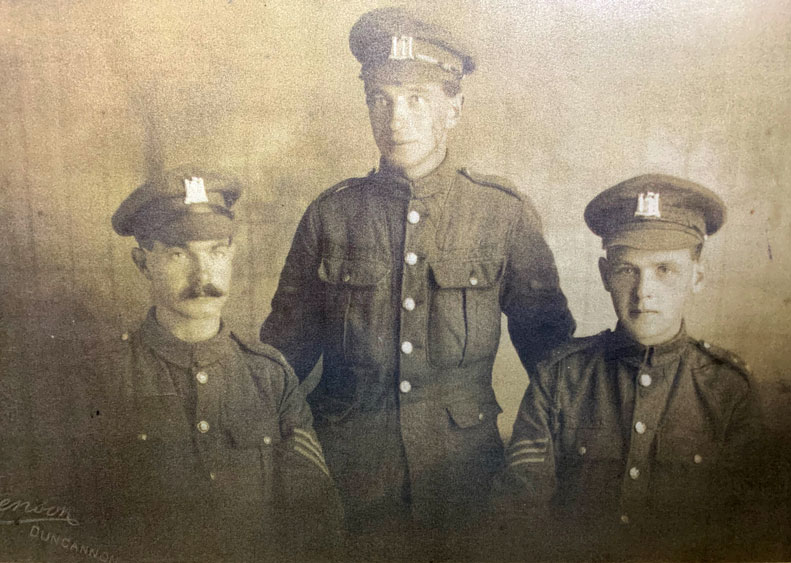
Sergeant Williamson (left) in Dungannon 1915-17. The man on the right may be Sergeant William Garnett Irwin.
Robert Alexander (Sandy) Williamson was born on 20 June 1888 at Drumcoo, Dungannon, County Tyrone, the fourth of eight children of civil bill officer Robert Williamson and his wife Sarah (née Fulton). His father died when he was just thirteen years old. By the time of the 1911 Census he was living at Drumcoo with his mother and four of his five surviving siblings, and working as a printer's compositor.
Williamson enlisted in the 6th (Inniskilling) Dragoons Service Squadron on 31 October 1914 (No. UD/114). According to a report in the Mid-Ulster Mail of 7 November:
Enthusiastic scenes were witnessed at Dungannon railway station on Monday morning, when six local members of the Ulster Volunteer Force left for Enniskillen to join the extra service squadron of the Royal Inniskilling Dragoons. They were Messrs. Jack Newell, Randall McManus, and Sandy Williamson, A Company, Dungannon Battalion U.V.F., and Messrs. W. J. Armstrong, Garnet Irwin, and Alexander Watt, of B Company. A very large crowd of friends and well-wishers had assembled to give them a hearty send-off, and as the train left the station loud cheers were raised and detonators exploded.
On 6 October 1915 Williamson embarked for France with his squadron, which was then serving as divisional cavalry to the 36th (Ulster) Division.
On 19 December the squadron diary reported that:
The following men are appointed snipers and will train under Capt Hulse – Ptes Armstrong, Connor, Robinson, Williamson, Campbell, Irwin.
In June 1916 the Inniskilling squadron joined C and F Squadrons of the North Irish Horse to form the 2nd North Irish Horse Regiment, serving as corps cavalry to X Corps until September 1917, when the regiment was disbanded and its men were transferred to the Royal Irish Fusiliers, an infantry regiment. Most, including Williamson, were transferred on 20 September and posted to the 9th (Service) Battalion – renamed the 9th (North Irish Horse) Battalion – joining it in the field at Ruyaulcourt five days later. Williamson was issued regimental number 41071.
He probably saw action with the battalion at the Battle of Cambrai in November and December 1917, and perhaps also during the retreat from St Quentin from 21 to 28 March 1918.
Williamson was wounded in the knee, probably on 4 September 1918, when the 9th (NIH) Battalion took part in an attack south of Wulverghem on the Ypres front at the beginning of the Advance to Victory offensive. The battalion's casualties for the day were four officers wounded, and 17 other ranks killed, 67 wounded and 11 missing.
Evacuated to the UK for treatment, it appears that the wound was not severe, for later that year he was allowed home on leave, where on 26 November 1918 he married Annie Bell Sinnamon in the Altedesert Church of Ireland Parish Church, County Tyrone. The couple's first child was born at Dungannon a year later.
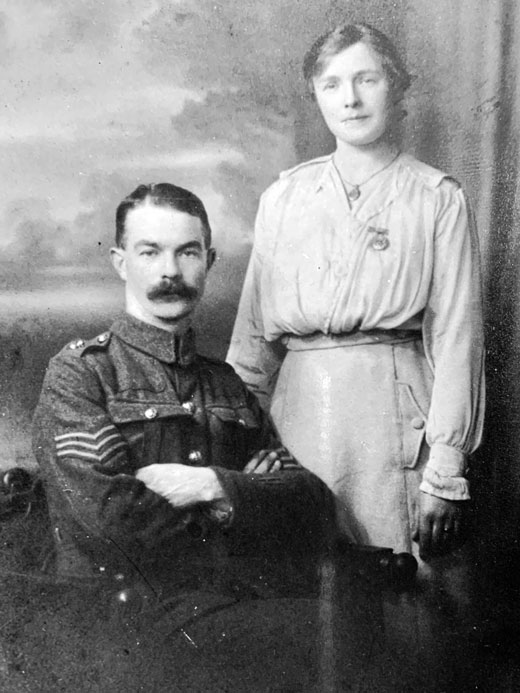
Williamson with his wife Annie, probably in 1918 or 1919. Note the two wound stripes on his left sleeve.
Williamson was demobilised and transferred to Class Z, Army Reserve, on 29 January 1919. By 1939 he was living at 22 Glanworth Drive, Belfast. During the Second World War he served in Northern Ireland in the Home Guard. (See image below, Williamson kneeling, front. He is wearing his First World War medal ribbons and Warrant Officer badges.)

He died at Glanworth Drive on 7 January 1955 and was buried in Carnmoney Cemetery East. The Belfast Telegraph reported that:
The death took place suddenly to-day of Mr. R. A. Williamson, of 22 Glanworth Drive, Belfast, who was a proof reader in the 'Belfast Telegraph.' He was in his late fifties. A native of Dungannon, Mr. Williamson served in the 1914-18 war as a sergeant in the Inniskilling Dragoons. He was a member of Grosvenor Masonic Lodge and the Orange Order. Surviving him are his wife, two sons and two daughters.
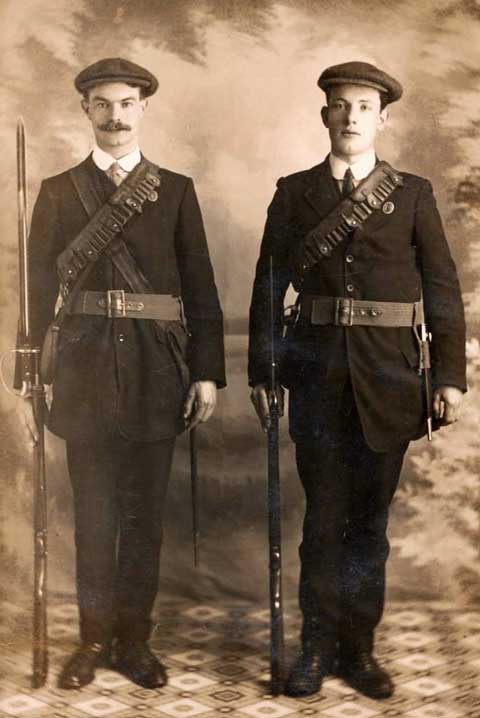
Williamson (left) in pre-war days wearing Ulster Volunteer Force equipment and arms

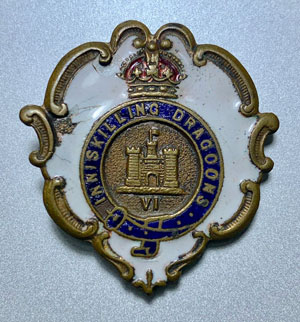
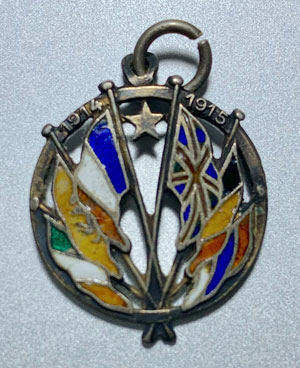
Three badges owned by Williamson
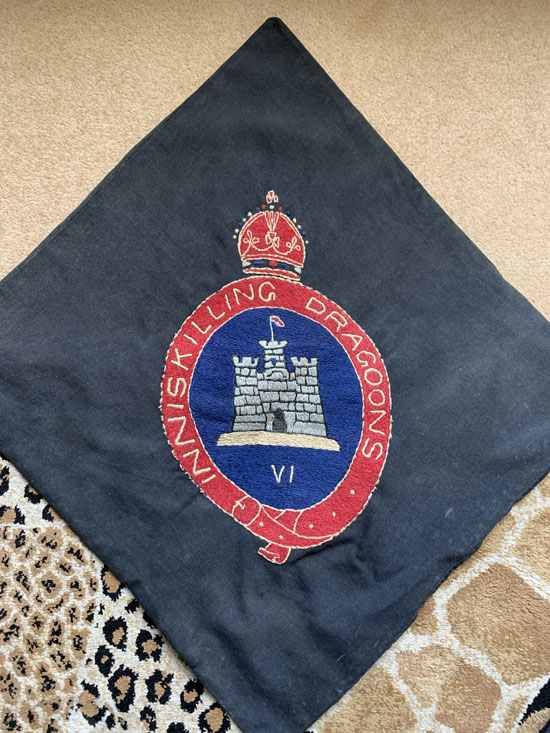
Cushion case believed to have been embroidered by Williamson while in hospital during the war.
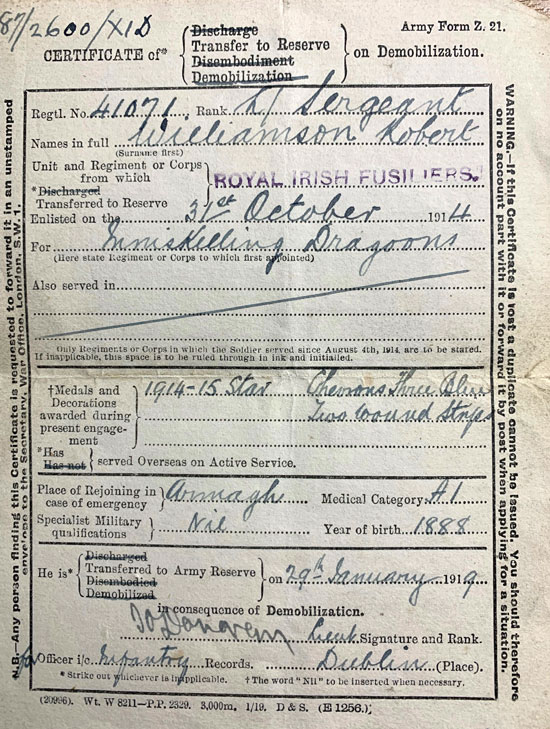
Williamson's demobilisation certificate. Note the reference to 'Two wound stripes', indicating that he was wounded twice.
Williamson's brother, James Whiteside Williamson, also served in the war, in 73rd and 13th Battalions of the Canadian Infantry (No.132149).
Images kindly provided by Sergeant Williamson's grandson, Stephen Williamson.
This page last updated 21 March 2023.
